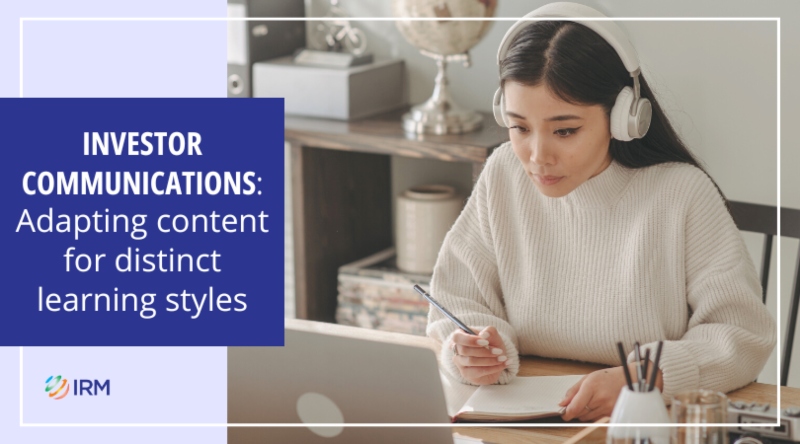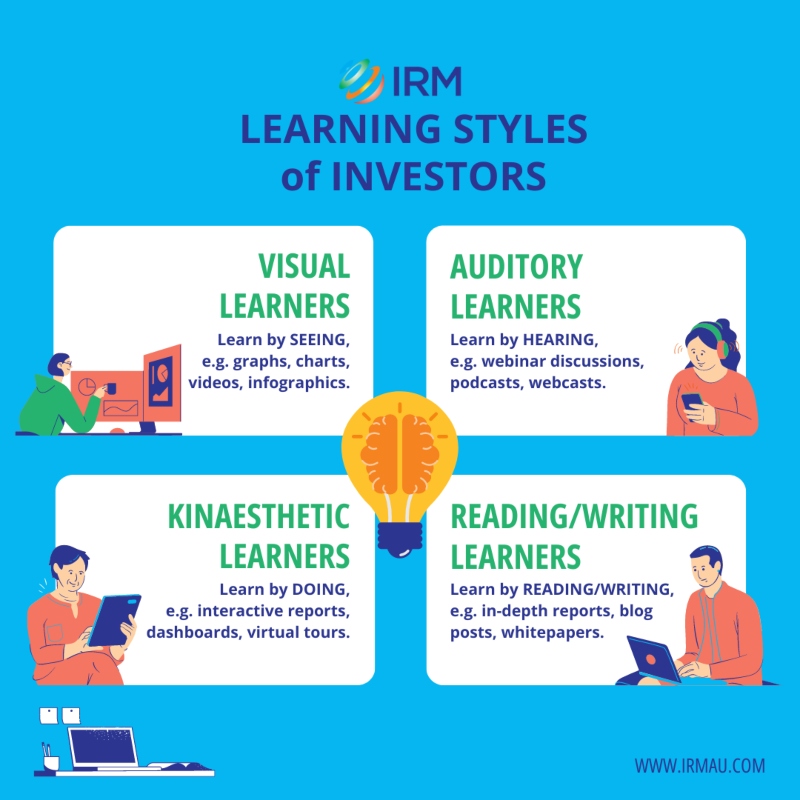
This is a 2-part series on the learning styles of investors. Read about "How to showcase content for investors' learning styles" here.
- Your investors have different learning types: visual, auditory, kinaesthetic, reading/writing.
- Accommodating these styles in your content delivery enriches your investors’ cognitive load, attention span, emotional connection, and representation.
- In this way, you effectively engage investors and provide them with details they need to make informed decisions.
As your ASX-listed company connects with investors, a vital aspect that may often be overlooked is the diverse learning styles they possess. Presenting information in a manner that resonates with your stakeholders’ different learning abilities facilitates a more impactful dialogue.
Like all humans, your investors come equipped with unique preferences for absorbing info, whether they are seasoned professionals or newcomers to the financial arena. Understanding these nuances can determine the efficacy of conveying your critical data and corporate narratives. It bridges the gap between your company's strategic vision and your stakeholders' comprehension.

UNPACK THE LEARNING STYLES OF INVESTORS
No two investors are the same. An in-depth written report that captivates a reader might leave an auditory learner yearning for more. Delve into the various learning types below:
- Visual learners – These investors’ preference for images is rooted in how their brains process facts. The brain processes visuals faster than text, and visual cues tend to stay in memory longer. Therefore, catering to this learning style ensures better information retention and engagement.
- Auditory learners – Investors who are auditory learners thrive on the rhythm and tone of spoken words. Hearing info spoken aloud triggers better understanding and retention for this group. By catering to this learning style, you're tapping into their auditory processing strengths.
 Auditory learners thrive on podcasts.
Auditory learners thrive on podcasts.
- Kinaesthetic learners – These investors learn best through hands-on experiences and practical involvement. Physical engagement enhances memory and understanding for this group. Incorporating interactive content addresses their need for tactile experiences.
- Reading/Writing learners – Investors who are reading/writing learners find comfort in the written word. Their preference is based on their ability to absorb and process information at their own pace. Reading allows them to pause, re-read, and reflect, leading to better comprehension.
UNDERSTAND THE VALUE OF DIVERSE CONTENT FORMATS
It’s not only important to see the varied learning styles of your investors. It’s key to understand why creating diverse content formats is essential for captivating your stakeholders:
- Cognitive load - This refers to the mental effort required to process knowledge. Providing content in various formats will accommodate different learning styles, reduce cognitive load, and making it easier for your investors to understand and retain info. When stakeholders encounter messages that align with their preferred learning style, they're more likely to engage and feel less overwhelmed.
- Attention span - Capturing and maintaining attention is a challenge in today's fast-paced world. Different learners have varying attention spans for several types of content. Visual learners might be interested with a short video, while reading/writing learners might prefer an in-depth blog post. By diversifying your communication formats, you cater to varying attention spans, ensuring your investors remain involved throughout their investment journey.
 Visual learners go for infographics and images.
Visual learners go for infographics and images.
- Emotional connection - Engaging content goes beyond conveying information; it creates an emotional connection. A variety of message formats evoke varying emotional responses. For instance, a powerful video can evoke empathy, while an interactive tool can spark curiosity. By tapping into these emotional triggers through diverse content, you're forging a stronger connection with your investors.
- Reach and representation - Not everyone processes data in the same way due to factors like disabilities or personal preferences. Offering messages in different formats enhances reach and representation. For example, visually impaired individuals may rely on auditory content, while those with limited internet connectivity may benefit from downloadable written resources. Diverse formats ensure that your news reaches a wider audience.
 Kinaesthetic learners appreciate interactive tools.
Kinaesthetic learners appreciate interactive tools.
Simply put
Adapting to various learning styles among stakeholders is an integral part of successful investor relations for ASX-listed companies like yours. Offering a diverse range of content formats effectively engages shareowners and provides them with the information they need to make informed decisions. In this way, the journey of investor education and engagement can become a more inclusive and interactive experience for all parties involved.
What's next? Click here for ideas on "How to showcase content for investors' learning styles".
Over to you
Showcase content that meets your stakeholders’ learning styles on your investor website and news delivery with a little help from IRM. We can also help you setup a Proactive video interview of your CEO to enhance your communications.
Find some of your ASX-listed peers we serve here. You’d be in good company. Chat us on +61 2 8705 5444 or clientrelations@irmau.com for more details.
Related posts
How to showcase content for investors' learning styles
How to make your website accessible to everyone

 Online Investor Engagement Specialists
Online Investor Engagement Specialists



